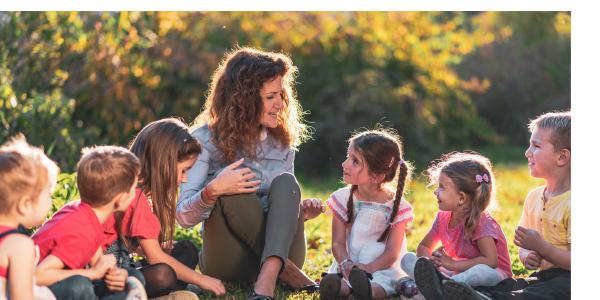10X. Inclusive and Nurturing Grief Support for Young Children and Families

You are here
One of the hardest things you may do as a preschool educator is nurture a grieving child. You will want to take the pain, fear, confusion, and intense sense of loss away, but you can’t. However, you can offer comfort to grieving children and families and help them begin to heal.
It takes years to develop an understanding about the concepts of death. When children lose an important person or cherished pet, they may need to talk about it repeatedly. They are trying to verify with you that their person or pet is not returning, and they are trying to understand more about this experience and associated strong feelings. (They may, for example, not understand the cause of the death and conclude that the person died because of something they thought or did or something they failed to do.) This may result in feelings of guilt. Grief can feel devastating to you both, but the patience, courage, and responsiveness you show will be your lasting gift to a child and family who are grieving.
Here are ten ways you can offer inclusive and nurturing grief support:
1. Learn about early developmental progressions related to death and grief.
As David Schonfeld writes in “How Early Childhood Educators Can Explain Death to Children”, young children may not understand death is permanent until they’re between the ages of 5 and 8. Children will revisit the death with greater awareness each time they reach a new developmental level. Knowing children’s developmental progressions through grief and mourning can help you notice and appropriately respond to a child’s unique situation and emotions.
2. Let the child lead.
Give children agency to choose how they will engage with their grief and how they will express emotions. Young children may not have the language to articulate their big grief feelings, so they may cry, act out, or display regression in an area or behaviors for a time. Children also may need a break from the intensity of grief and may even act silly. You can offer ongoing and open-ended playful opportunities, like natural clay to knead and shape or a collection of loose parts to explore.
3. Listen reflectively.
Listening with intention involves aiming to understand what another is saying and sharing it back to them (to ensure that they have been accurately heard). No one can tell another person how to feel. Rather than projecting what you want the child to be feeling or relating stories about your own experiences, ask questions and provide the space for the child to share their memories and their words. This involves listening with intention, and it will honor what the child is experiencing in the moment.
4. Offer a safe haven.
Demonstrate through words and actions that your setting is a safe place—not only to ask questions and learn about topics that may confuse or frighten children, but a place that won’t change amid the other shifts a child is experiencing. Weave into your classroom community a willingness to hold difficult conversations with caring adults and peers. Family members may also be grieving, and when children ask questions or talk about the person who died, family members may cry or otherwise show discomfort. Children may falsely conclude that they did something wrong and made their family members cry. Educators may have the emotional distance, developmental understanding, and practical experience to provide support that may be different from what they may find at home. The death of a loved one changes significant things in a child’s life, so it’s also important to make an effort to honor the rituals and routines in your setting. Something as seemingly simple as keeping centers or materials the same for longer than usual can foster a sense of predictability and security each day.
5. Create intentional spaces for children to play out their emotions after a death.
Play is a key outlet for grief. Explanations about death that are offered to children, such as religious explanations, are often abstract and difficult for children to understand. Play can help children start to make sense of the abstract and is relational and healing. While engaged in play, young children can revisit things they have seen, heard, and felt as a way to gain competency and confidence. (Peek-a-boo is one of the first games about death and is a way for very young children to try to work through worries about loss; the literal translation of “peek-a-boo” from Old English is “alive-or-dead.”)
A grieving child will create scenarios in play to voice the questions or worries they have about death. For example, a child who has recently attended a funeral may arrange hollow blocks as tombstones and place flowers from the dramatic play area nearby as they work to make sense of shared mourning and ceremony. You can engage with the child and wonder together about what feelings people might have at a funeral. That said, if children seem stuck repetitively reenacting trauma associated with the death in their play (such as repeatedly act out what happened when they witnessed the violent death of a family member) without showing a decrease in distress, then seek the advice of a mental health provider or the child’s pediatrician—such post-traumatic play may be a sign of post-traumatic stress disorder (PTSD).
6. Speak sensitively and openly about the person who died, and use clear and concrete terms about death.
Talk about the child’s person or pet who died and demonstrate your openness to help them process the death. Mention their person’s name. Understand that talking about death doesn’t bring on grief; rather, it facilitates the grieving process. Explain the concepts of death such as irreversibility and finality of death, and help children understand what they mean. Avoid euphemisms like “sleeping” or “lost,” which may confuse and frighten children.
7. Teach children that everything that is alive eventually dies.
Still, it is upsetting for those who love the person or animal that died. Help young children understand life and death by providing concrete learning experiences with living things found in their own natural environments. For example, Dani Porter Born writes about an experience with young children finding baby rabbits that were partially eaten by a coyote. “Together, we decided it’s fine to be both sad for the rabbit and happy for the coyote, because every living creature—ourselves included—needs to eat." This illustrated for the children that the life cycle within nature includes the death of one animal and sustains (as in food) another. And children learned that they are capable of holding two different feelings at once, sadness and happiness. [Read more about a nature-based approach to foster children’s understanding of death in Born’s “Life and Death in Nature: Outdoor Discoveries Bring the Topic of Death into the Preschool Classroom"].
8. Integrate a variety of cultural customs and approaches to mourning a death.
Cultural beliefs and practices influence how we cope with death and how we mourn. To cultivate an inclusive approach to understanding death and grief, share with children about how different cultures honor someone who has died. Through books, educational media, guest speakers, and insights from families, you can explore different traditions and vocabulary through ongoing or extended projects.
9. Nurture the grieving adults in the family.
Along with strategies and materials used with children, extend your care and concern to grieving family members. Make it as easy as possible for family members to stay in touch with you. Be intentional about checking in regularly and often. Offer extra help and patience with paperwork and other school tasks for overwhelmed, grieving adults. Help family members know how to talk with and support their grieving children, and let them know what they are doing that is helping their children. Caregivers who are grieving themselves may feel particularly overwhelmed and worried that they don’t know what to say or do; they may fail to see what they are doing right. Refer families to resources such as this free booklet on how to support grieving children, After a Loved One Dies.
10. Help families connect with local support services and programs.
Typically, grief support centers, programs, and camps serve children and their families at little or no cost to the recipients. Grief groups provide safe spaces, and they are designed to address the needs of family members and to promote healthier outcomes for grieving children. To access local bereavement support programs in your community, refer to the National Bereavement Resource Guide: State by State Bereavement Listing compiled by New York Life and Eluna.
Photographs: © Getty Images.
Copyright © 2021 National Association for the Education of Young Children. See permissions and reprints online at NAEYC.org/resources/permissions.
 This article supports the following NAEYC Early Learning Programs standards and topics
This article supports the following NAEYC Early Learning Programs standards and topics
Standard 2: Curriculum
2B: Social and Emotional Development
Standard 8: Community Relationships
8A: Linking with the Community
Suzanne J. Bayer is a writer and trainer at suzannejbayer.com and was previously a teacher at Allen Creek Preschool in Ann Arbor, Michigan.